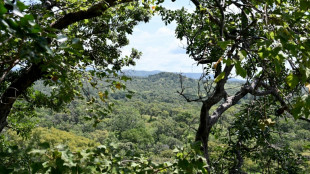
-
 Tehran toy museum brings old childhood memories to life
Tehran toy museum brings old childhood memories to life
-
Iran banking on Iraq vote to retain regional influence

-
 Daughter of 'underground' pastor urges China for his release
Daughter of 'underground' pastor urges China for his release
-
Trump the Great? President steps up power moves

-
 Fire ravages French monastery dubbed 'Notre-Dame of the Ardennes'
Fire ravages French monastery dubbed 'Notre-Dame of the Ardennes'
-
Bills outlast Chiefs while NFL-best Colts fall to Steelers

-
 NBA champion Thunder roll over Pelicans to remain unbeaten
NBA champion Thunder roll over Pelicans to remain unbeaten
-
Eliud Kipchoge unveils plan to run 7 marathons on 7 continents

-
 Milan deny Roma top spot in Serie A, Inter beat Verona
Milan deny Roma top spot in Serie A, Inter beat Verona
-
Lens back up to third in Ligue 1 as Lyon held at Brest

-
 NFL-best Colts fall to Steelers, Packers lose to Carolina
NFL-best Colts fall to Steelers, Packers lose to Carolina
-
'Regretting You' wins spooky slow N. American box office

-
 'Just the beginning' as India lift first Women's World Cup
'Just the beginning' as India lift first Women's World Cup
-
Will Still sacked by struggling Southampton

-
 Malinin wins Skate Canada crown with stunning free skate
Malinin wins Skate Canada crown with stunning free skate
-
Barca beat Elche to recover from Clasico loss

-
 Jamaica deaths at 28 as Caribbean reels from colossal hurricane
Jamaica deaths at 28 as Caribbean reels from colossal hurricane
-
Verma and Sharma power India to first Women's World Cup triumph

-
 Auger-Aliassime out of Metz Open despite not yet securing ATP Finals spot
Auger-Aliassime out of Metz Open despite not yet securing ATP Finals spot
-
Haaland fires Man City up to second in Premier League

-
 Sinner says staying world number one 'not only in my hands'
Sinner says staying world number one 'not only in my hands'
-
Ready for it? Swifties swarm German museum to see Ophelia painting

-
 Pope denounces violence in Sudan, renews call for ceasefire
Pope denounces violence in Sudan, renews call for ceasefire
-
Kipruto, Obiri seal Kenyan double at New York Marathon

-
 OPEC+ further hikes oil output
OPEC+ further hikes oil output
-
Sinner returns to world number one with Paris Masters win

-
 Sinner wins Paris Masters, reclaims world No. 1 ranking
Sinner wins Paris Masters, reclaims world No. 1 ranking
-
Nuno celebrates first win as West Ham boss

-
 Obiri powers to New York Marathon win
Obiri powers to New York Marathon win
-
Two Louvre heist suspects a couple with children: prosecutor

-
 Verma, Sharma help India post 298-7 in Women's World Cup final
Verma, Sharma help India post 298-7 in Women's World Cup final
-
Inter snapping at Napoli's heels, Roma poised to pounce

-
 India space agency launches its heaviest satellite
India space agency launches its heaviest satellite
-
Wolves sack Pereira after winless Premier League start

-
 Debutants Berkane among CAF Champions League top seeds
Debutants Berkane among CAF Champions League top seeds
-
Sundar steers India to five-wicket win over Australia in 3rd T20

-
 What we know about the UK train stabbings
What we know about the UK train stabbings
-
Jonathan Milan wins wet Tour de France Singapore Criterium

-
 Canadian teen Mboko wins Hong Kong Open for second WTA title
Canadian teen Mboko wins Hong Kong Open for second WTA title
-
Two children among dead in Russian blitz on Ukraine

-
 South Africa opt to bowl against India in Women's World Cup final
South Africa opt to bowl against India in Women's World Cup final
-
Dominant McKibbin wins Hong Kong Open to seal Masters spot

-
 US Navy veterans battle PTSD with psychedelics
US Navy veterans battle PTSD with psychedelics
-
'Unheard of': Dodgers in awe of iron man Yamamoto

-
 UK police probe mass train stabbing that wounded 10
UK police probe mass train stabbing that wounded 10
-
'It's hard' - Jays manager Schneider rues missed chances in World Series defeat

-
 Women's cricket set for new champion as India, South Africa clash
Women's cricket set for new champion as India, South Africa clash
-
Messi scores but Miami lose as Nashville level MLS Cup playoff series

-
 Dodgers clinch back-to-back World Series as Blue Jays downed in thriller
Dodgers clinch back-to-back World Series as Blue Jays downed in thriller
-
Vietnam flood death toll rises to 35: disaster agency


New tools give researchers hope for fungus-ravaged US bats
Standing at a woodland entrance to the world's longest cave system in Kentucky, a park ranger warns those about to enter of an extremely deadly fungus -- not for humans, but for the bat populations it has devastated across North America.
In one of the most significant losses of wildlife in modern history, the fungus, which causes a disease called white-nose syndrome, has killed millions of the flying mammals since arriving in the eastern United States from Europe nearly 20 years ago.
Two decades on, no cure exists. But scientists are finally emerging with potential solutions.
And their research comes as the disease -- which sprouts white fuzz on the bats' tiny noses, ears and wings -- is spreading to the American West.
White-nose syndrome (WNS) was first confirmed at Mammoth Cave National Park in Kentucky in 2013, thriving in the pitch-black, cool conditions of its labyrinthine tunnels, which the group of visitors quickly descended into for their tour.
If WNS seems like a problem just for bats, scientists say, think again. The insect-eating animals play a vital ecological role and their loss is already reverberating.
All of the repercussions are not entirely understood. However in a recent study published in the journal Science, researchers linked the collapse of North American bat populations with higher use of pesticide and increased human infant mortality.
Particularly in the disease's early days, researches witnessed grisly scenes: dead bats clinging to the ceiling next to sick bats, and diseased bats crawling along the floor, especially in the northeast United States.
Further south at Mammoth Cave, located in an extremely cavernous region of verdant rolling hills and forests, bats have tended to head out into the wilderness to die, likely due to warmer winter weather, simply disappearing forever.
- Mass mortality -
The United States and Canada are home to more than 40 bat species, with WNS affecting those that hibernate -- although not all of them.
Counting bats is extremely difficult, but researchers widely agree the disease killed more than 90 percent of the three most impacted species -- the northern long-eared, tricolored and little brown bat which used to be extremely common.
At Mammoth Cave, mass mortality has also occurred among the Indiana bat, the park's cave resources management specialist, Rick Toomey, told AFP.
More than 400 miles (640 kilometers) of mapped passageways wind beneath the park, which Toomey compared to "a plate of spaghetti," attracting visitors who may not have known or been thinking about WNS.
"It doesn't cross my mind often at all, only when someone brings it up like they did today," Makenzie Johnson, a 24-year-old student visiting from Indiana, told AFP after the tour.
- Right tool, right time -
White-nose syndrome is caused by the fungus Pseudogymnoascus destructans (Pd), which infects bats during hibernation, waking them more easily and causing them to use up their energy reserves.
Scientists have been scrambling to find a solution -- so far with only partial results.
"If we can come up with a lot of different tools, and we understand how to use them, and use them in the right places at the right time, we could help get a number of bats through that initial phase of disease when we see high mortality," Michelle Verant, a wildlife veterinarian with the National Park Service, told AFP.
One of those tools is vaccines, which are fairly rare for fungal diseases, but are showing promise with comparatively more vaccinated bats returning to maternal roosts, she said.
According to Jonathan Reichard, assistant national coordinator for WNS at the US Fish and Wildlife Service, various disinfection tools for hibernation sites are being studied.
One is a chemical called polyethylene glycol 8000 that is sprayed in caves while bats are away in summer, reducing Pd's presence. Another is the application of UV light. But scientists warn other organisms can be harmed in the process.
Researchers are also fumigating caves and their bats with volatile organic compounds to slow the fungus's growth. And there is even a probiotic skin treatment, based on naturally occurring bacteria.
A double-stranded RNA application is also now under development, "which is something that can be highly specific to the fungus," Reichard added.
"We've gone from sort of having no idea what was happening to now having a suite of tools relevant for use in different areas and different situations," he said.
P.Silva--AMWN



